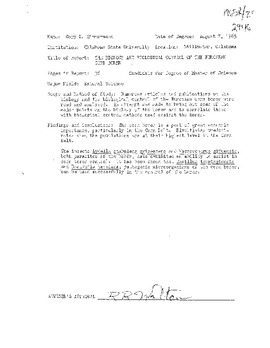| dc.contributor.advisor | Walton, R. R. | |
| dc.contributor.author | Zimmerman, Gary L. | |
| dc.date.accessioned | 2016-02-05T15:45:16Z | |
| dc.date.available | 2016-02-05T15:45:16Z | |
| dc.date.issued | 1965-08 | |
| dc.identifier.uri | https://hdl.handle.net/11244/27669 | |
| dc.description.abstract | Scope and Method of Study: Numerous articles and publications on the biology and the biological control of the European corn borer were read and analyzed. An attempt was made to bring out some of the major points on the biology of the borer and to correlate these with biological control methods used against the borer. | |
| dc.description.abstract | Findings and Conclusions: The corn borer is a pest of great economic importance, particularly in the Corn Belt. Bivoltinism predominates when the populations are at their highest level in the Corn Belt. | |
| dc.description.abstract | The insects Lydella stabulens grisescens and Macrocentrus gifuensis, both parasites of the borer, have exhibited an ability to assist in corn borer control. It has been shown that Bacillus thuringiensis and Beauveria bassiana, pathogenic microorganisms of the corn borer, can be used successfully in the control of the borer. | |
| dc.format | application/pdf | |
| dc.language | en_US | |
| dc.rights | Copyright is held by the author who has granted the Oklahoma State University Library the non-exclusive right to share this material in its institutional repository. Contact Digital Library Services at lib-dls@okstate.edu or 405-744-9161 for the permission policy on the use, reproduction or distribution of this material. | |
| dc.title | Biology and biological control of the European corn borer | |
| dc.contributor.committeeMember | Bruneau, L. Herbert | |
| osu.filename | Thesis-1965R-Z74b.pdf | |
| osu.accesstype | Open Access | |
| dc.type.genre | Master's Report | |
| dc.type.material | Text | |
| thesis.degree.discipline | Natural Science | |
| thesis.degree.grantor | Oklahoma State University | |
